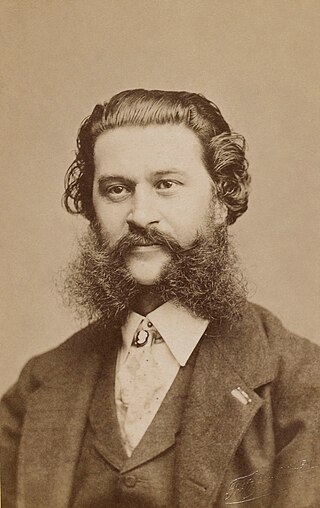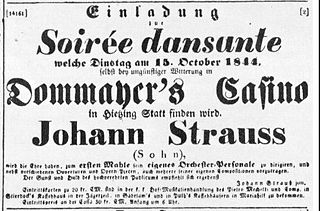Related Research Articles

Johann Baptist Strauss II, also known as Johann Strauss Jr., the Younger or the Son, was an Austrian composer of light music, particularly dance music and operettas as well as a violinist. He composed over 500 waltzes, polkas, quadrilles, and other types of dance music, as well as several operettas and a ballet. In his lifetime, he was known as "The Waltz King", and was largely responsible for the popularity of the waltz in Vienna during the 19th century. Some of Johann Strauss's most famous works include "The Blue Danube", "Kaiser-Walzer", "Tales from the Vienna Woods", "Frühlingsstimmen", and the "Tritsch-Tratsch-Polka". Among his operettas, Die Fledermaus and Der Zigeunerbaron are the best known.

The Kuss-Walzer, Op. 400 is a waltz by Johann Strauss II composed in 1881. The waltz was originally dedicated to his second wife, Angelika Dittrich (1850–1919), but Strauss withdrew that dedication after their divorce in 1882. The waltz comprises melodies from Strauss' popular operetta Der lustige Krieg and is an orchestral treatment of the act 2 aria "Nur für Natur" which was a hit when first performed. Eduard Strauss, the composer's brother, first conducted the orchestral piece at the Court Ball in Vienna in 1882.
Cagliostro-Walzer op.370 is a waltz by Johann Strauss II composed in 1875 based on themes from his operetta, Cagliostro in Wien which premiered on 27 February 1875 at the famous Theater an der Wien.

Nordseebilder op. 390 is a waltz by Johann Strauss II composed in 1879.

Wiener Blut Op. 354 is a waltz by Johann Strauss II first performed by the composer on 22 April 1873. The new dedication waltz was to celebrate the wedding of the Emperor Franz Joseph I's daughter Archduchess Gisela Louise Maria and Prince Leopold of Bavaria. However, the waltz was also chiefly noted by Strauss' biographers as the début of Strauss with the Vienna Philharmonic Orchestra where for many years, the Philharmonic had dismissed any association with the 'Waltz King' as it had not wished to be associated with mere 'light' or 'pops' music. The festival ball celebrating the event was held at the Musikverein Hall which is the venue for the present day Neujahrskonzert.
Schatz-Walzer, Op. 418, is a Viennese waltz by Johann Strauss II composed in 1885. The melodies in this waltz were drawn from Strauss' operetta Der Zigeunerbaron, which premiered to critical acclaim on 24 October 1885. Der Zigeunerbaron, a Hungarian-influenced work, remained Strauss' best-remembered operetta after Die Fledermaus. The waltz version was first performed on 22 November that year in the concert hall of the Vienna Musikverein, with Eduard Strauss conducting.
Leitartikel op. 273 is a waltz composed by Johann Strauss II in 1863 and first performed at the Vienna's Artists and Journalists' Association ball called 'Concordia', which glorifies the Roman goddess of civic harmony, on 19 January 1863. Theoretically, this work would have been Strauss' only contribution towards the festivity of Vienna's Fasching of that year as his health did not permit laborious hours of conducting nor of composing.
Accelerationen (Accelerations), op. 234, is a waltz composed by Johann Strauss II in 1860 for the Engineering Students' Ball at the Sofienbad-Saal in Vienna. It is one of his best-known waltzes, famous especially for its rapidly accelerating opening waltz theme.
Mephistos Höllenrufe, Op. 101, is a waltz composed by Johann Strauss II in 1851. It was first performed at the Vienna Volksgarten as part of a festival preceding Strauss' departure for a tour of Germany. The title of the composition is a quotation from the Bible: "And the devil [Mephistopheles] [...] was cast into the lake of fire and brimstone, where the beast and the false prophet are, and shall be tormented day and night for ever and ever". A reporter for the Wiener Allgemeine Theaterzeitung commented on Strauss' waltz that it "received such a favourable reception, on account of its effective and original melodies and brilliant instrumentation, that it had to be repeated three times". Especially colourful, and keeping with the work's ominous title, is the second waltz theme: its cheerful, ascending tune is suddenly interrupted, and then answered by a sinister chromatic descending passage. Some of the waltz themes of the work are found in close proximity to one another in the earliest of Strauss' "sketchbooks", and were probably written in the first half of 1851.
Seid umschlungen, Millionen!, opus 443, is a waltz composed by Johann Strauss II. It was first performed at the Great Hall of the Musikverein in Vienna in March 1892. The title of the waltz was borrowed from Friedrich Schiller's Ode an die Freude. The composition was dedicated to Strauss' close friend Johannes Brahms.
O schöner Mai!, Op. 375, is a waltz composed by Johann Strauss II. It features melodies from Strauss's fifth operetta, Prinz Methusalem. The waltz was first performed in January 1877, with Eduard Strauss conducting. The principal waltz theme of this work is a quote from the Act 3 duet for Pulcinella and Methusalem, while the remaining melodies are taken from Acts 1 and 2, including the Act 1 Chorus and Ensemble, "O schöner Mai!".
Phänomene (Phenomena), opus 193, is a waltz composed by Johann Strauss II. The waltz was dedicated to the technical students of the Vienna University, and was first performed on the occasion of their ball in the Sofienbad-Saal in February 1857. This composition belongs to the series of Strauss waltzes which reflect the composer's fascination for avant-garde orchestrations and harmonic styles of Hector Berlioz and Richard Wagner.

Sinngedichte, Op. 1, is a waltz composed by Johann Strauss II in 1844 for his debut as a composer at Dommayer's Casino in Vienna. The waltz was played along with several other compositions that Strauss had written for the occasion, such as the waltz Gunstwerber and the polka Herzenslust. The waltz was an unprecedented success when first performed, and had to be repeated a record nineteen times.
Carnevalsbilder, opus 357, is a waltz composed by Johann Strauss II. The waltz is based on melodies from Strauss' operetta Der Karneval in Rom. Strauss conducted its first performance in Vienna on July 9, 1873. Oscar Straus later arranged the second waltz theme of Carnevalsbilder for his operetta Drei Walzer as the soprano aria Ich liebe das Leben.
Aus den Bergen, opus 292, is the name of a waltz composed by Johann Strauss II. The work was first performed in Pavlovsk on October 2, 1864, under the title In den Bergen. The composition was dedicated to the music critic Eduard Hanslick. Critics commented on Strauss' waltz that "after a long time a new waltz from Johann Strauss has appeared, which is distinguished by noble and graceful character, and further distinguished by extraordinarily masterful instrumentation." The first Viennese performance of the waltz was in the Volksgarten as part of a benefit concert commemorating Strauss' twentieth anniversary of his debut as a composer.
Promotionen (Graduations), Op. 221, is the name of a waltz composed by Johann Strauss II. It was dedicated to the law students at the Vienna University, and was first performed under the title of Die Präparanden, a term referring to students who are preparing for their final examinations. The waltz was not very successful when first performed in the Sofienbad-Saal on February 8 1859: the Fremden-Blatt, although praising the execution of the waltz, said that it "lacked the rhythm and melody of older Strauss compositions." However, a reviewer for the Wiener Allgemeine Theaterzeitung was less critical of the composition, commenting that "in particular the first, third and fifth [waltz sections] are rich in fresh and attractive melodies [...] through this composition Strauss has lately demonstrated that he still has at his disposal a profusion of piquant and original melodies."
Rhadamantus-Klänge, Op. 94, is a waltz composed by Johann Strauss II. It was written for the 1851 Vienna Carnival. The title of the work was named after Rhadamanthus, one of the judges of the underworld in Greek mythology. Eduard Strauss, the composer's youngest brother, included the waltz's opening number in his potpourri Bluthenkranz Johann Strauss'scher Walzer, opus 292.
Lava-Ströme, opus 74, is the name of a waltz composed by Johann Strauss II. It was written to commemorate the volcanic activity within Vesuvius in 1850. The waltz was first performed at a benefit ball going under the title of a "Ball in Vesuvius" at the Sofienbad-Saal in Vienna on January 29, 1850.
Abschied von St. Petersburg, opus 210, is the name of a waltz composed by Johann Strauss II. The work was first performed at a benefit concert in Pavlovsk on September 5, 1858, as part of a tour of Russia that Strauss was conducting. In keeping with the vogue then current in Russia for the French language, the work was entitled as Mes adieux à St. Pétersbourg. Less than a week after his return to his home city of Vienna, Strauss conducted the first Viennese performance of the work at the Vienna Volksgarten.
Farewell to America is the name of a waltz composed by Johann Strauss II. In the immediate wake of the composer's visit to the United States in the summer of 1872, when he conducted several times in Boston and New York, no less than seven publishers issued waltzes supposedly composed by Strauss. Only two from the total of nine compositions that were published are known to have been performed by Strauss during his tour of the United States: the Jubilee Waltz and the Manhattan Waltzes. It is unknown whether or not the other compositions that were published were written by Strauss while he was in America, completed by him after his return to Vienna and sent through the mail, or that some of the publications had nothing to do with Strauss himself, but were compiled by publishers anxious to benefit from Strauss' American tour and the clamour for new Strauss music.
References
- ↑ "STRAUSS II, J.: Edition - Vol. 24 CD". NaxosDirect. Retrieved 2008-10-22.